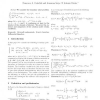Free Online Productivity Tools
i2Speak
i2Symbol
i2OCR
iTex2Img
iWeb2Print
iWeb2Shot
i2Type
iPdf2Split
iPdf2Merge
i2Bopomofo
i2Arabic
i2Style
i2Image
i2PDF
iLatex2Rtf
Sci2ools
WCE
2007
2007
No Classic Boundary Conditions
–We consider the boundary value problem: x(m) (t) = f(t, x(t)), a ≤ t ≤ b, m > 1 x(a) = β0 ∆x(k) ≡ x(k) (b) − x(k) (a) = βk+1, k = 0, ..., m − 2 where x(t) = (x(t), x (t), ...., x(m−1) (t)), βi ∈ R, i = 0, ..., m − 1, and f is continuous at least in the interior of the domain of interest. We prove the existence and uniqueness of the solution under certain conditions.
| Added | 07 Nov 2010 |
| Updated | 07 Nov 2010 |
| Type | Conference |
| Year | 2007 |
| Where | WCE |
| Authors | Francesco A. Costabile, Annarosa Serpe, Antonio Bruzio |
Comments (0)

